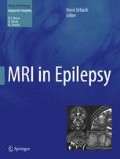Abstract
This chapter describes phakomatoses associated with epilepsy, namely, tuberous sclerosis complex, Sturge–Weber syndrome, neurofibromatosis type 1, meningioangiomatosis, hypomelanosis of Ito, epidermal nevus syndrome and variants, incontinentia pigmenti, lipoproteinosis, and linear scleroderma, which is also known as en coup de sabre syndrome.
Access this chapter
Tax calculation will be finalised at checkout
Purchases are for personal use only
References
Bouwes Bavinck JN, van de Kamp JJP (1985) Organoid naevus phakomatosis: Schimmelpenning–Feuerstein–Mims syndrome. Br J Derm 113:491–492
Carreño M, Donaire A, Barceló MI et al (2007) Parry–Romberg syndrome and linear scleroderma in coup de sabre mimicking Rasmussen encephalitis. Neurology 68(16):1308–1310
Chiang KL, Chang KP, Wong TT, Hsu TR (2009) Linear scleroderma “en coup de sabre”: initial presentation as intractable partial seizures in a child. Pediatr Neonatol 50(6):294–298
Claeys KG, Claes LR, Van Goethem JW et al (2007) Epilepsy and migraine in a patient with Urbach–Wiethe disease. Seizure 16:465–468
Cohen MM Jr, Hayden PW (1979) A newly recognized hamartomatous syndrome. Birth Defects Orig Artic Ser 15:291–296
Dietrich RB, Glidden DE, Roth GM et al (1998) The Proteus syndrome: CNS manifestations. Am J Neuroradiol 19(5):987–990
Enjoltas O, Riche MC, Merland JJ (1985) Facial port-wine stains and Sturge–Weber syndrome. Pediatrics 76:48–51
Gill DS (2006) Age-related findings on MRI in neurofibromatosis type 1. Pediatr Radiol 36:1048–1056
Gonçalves FG, de Melo MB, de L Matos V et al (2010) Amygdalae and striatum calcification in lipoid proteinosis. Am J Neuroradiol 31(1):88–90
Gorlin RJ, Cohen MM, Hennekam RCM (2001) Syndromes of the Head and Neck, 4th edn. Oxford University Press, New York, pp 484–488
Greene AK, Rogers GF, Mulliken JB (2007) Schimmelpenning syndrome: an association with vascular anomalies. Cleft Palate Craniofac J 44:208–215
Happle R (2010) The group of epidermal nevus syndromes. Part I. Well defined phenotypes. J Am Acad Dermatol 63(1):1–22
Hennel SJ, Ekert PG, Volpe JJ, Inder TE (2003) Insights into the pathogenesis of cerebral lesions in incontinentia pigmenti. Pediatr Neurol 29(2):148–150
Hornstein OP, Knickenberg M (1974) Zur Kenntnis des Schimmelpenning-Feuerstein-Mims-Syndroms (Organoide Naevus-Phakomatose) [in German]. Arch Derm Forsch 250:33–50
Hsieh DT, Chang T (2011) Incontinentia pigmenti: skin and magnetic resonance imaging findings. Arch Neurol 68(8):1080
Hubert JN, Callen JP (2002) Incontinentia pigmenti presenting as seizures. Pediatr Dermatol 19(6):550–552
Ito M (1952) Studies of melanin: XI. Incontinentia pigmenti achromiens. Tohoku J Exp Med 55(suppl):55–57
Jallo GI, Kothbauer K, Mehta V et al (2005) Meningioangiomatosis without neurofibromatosis: a clinical analysis. J Neurosurg 103(4 Suppl):319–324
Krueger DA, Care MM, Holland K et al (2010) Everolimus for subependymal giant-cell astrocytomas in tuberous sclerosis. N Engl J Med 363(19):1801–1811
Longo D, Paonessa A, Specchio N et al (2011) Parry–Romberg syndrome and Rasmussen encephalitis: possible association. Clinical and neuroimaging features. J Neuroimaging 21(2):188–193
McCall S, Ramzy MI, Cure JK, Pai GS (1992) Encephalocraniocutaneous lipomatosis and the Proteus syndrome: distinct entities with overlapping manifestations. Am J Med Genet 43:662–668
Meuwissen ME, Mancini GM (2012) Neurological findings in incontinentia pigmenti; a review. Eur J Med Genet 55(5):323–331
NIH Consensus Development Conference (1988) Neurofibromatosis: conference statement. Arch Neurol 45:575–578
Osborne JP, Fryer A, Webb D (1991) Epidemiology of tuberous sclerosis. Ann NY Acad Sci 615:125–127
Pascual-Castroviejo I, Roche MC, Martinez Fernández V et al (1994) Incontinentia pigmenti: MR demonstration of brain changes. Am J Neuroradiol 15(8):1521–1527
Pavone L, Curatolo P, Rizzo R et al (1991) Epidermal nevus syndrome: a neurologic variant with hemimegalencephaly, gyral malformation, mental retardation, seizures, and facial hemihypertrophy. Neurology 41:266–271
Roach ES, Gomez MR, Northrup H (1998) Tuberous Sclerosis Complex Consensus Conference: revised clinical diagnostic criteria. J Child Neurol 13:624–628
Sapp JC, Turner JT, van de Kamp JM et al (2007) Newly delineated syndrome of congenital lipomatous overgrowth, vascular malformations, and epidermal nevi (CLOVE syndrome) in seven patients. Am J Med Genet 143A:2944–2958
Seifert F, Bien CG, Schellinger PD et al (2011) Parry–Romberg syndrome with chronic focal encephalitis: two cases. Clin Neurol Neurosurg 113(2):170–172
Sugarman JL (2007) Epidermal nevus syndromes. Semin Cutan Med Surg 26(4):221–230
Turner JT, Cohen MM, Biesecker LG (2004) Reassessment of the Proteus syndrome literature: application of diagnostic criteria to published cases. Am J Med Genet 130A:111–122
Urbach E, Wiethe C (1929) Lipoidosis cutis et mucosae. Virch Arch Pathol Anat 273:285–319
Wiedemann HR, Burgio GR, Aldenhoff P et al (1983) The Proteus syndrome. Partial gigantism of the hands and/or feet, nevi, hemihypertrophy, subcutaneous tumors, macrocephaly or other skull anomalies and possible accelerated growth and visceral affections. Eur J Pediatr 140(1):5–12
Wolf NI, Krämer N, Harting I et al (2005) Diffuse cortical necrosis in a neonate with incontinentia pigmenti and an encephalitis-like presentation. Am J Neuroradiol 26:1580–1582
Author information
Authors and Affiliations
Corresponding author
Editor information
Editors and Affiliations
Rights and permissions
Copyright information
© 2013 Springer-Verlag Berlin Heidelberg
About this chapter
Cite this chapter
Urbach, H. (2013). Neurocutaneous Diseases (Phakomatoses). In: Urbach, H. (eds) MRI in Epilepsy. Medical Radiology(). Springer, Berlin, Heidelberg. https://doi.org/10.1007/174_2012_780
Download citation
DOI: https://doi.org/10.1007/174_2012_780
Publisher Name: Springer, Berlin, Heidelberg
Print ISBN: 978-3-642-25137-5
Online ISBN: 978-3-642-25138-2
eBook Packages: MedicineMedicine (R0)

